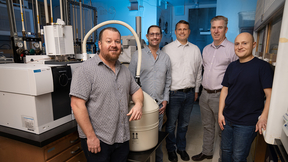W80-4 Life Extension Program enters Phase 6.4, production engineering
 (Download Image)
(Download Image)
An engineer in the W80-4 Life Extension Program conducts environmental testing on a mock test unit. Photo by Garry McLeod/LLNL.
In March, the Department of Energy’s National Nuclear Security Administration's Deputy Administrator for Defense Programs approved the W80-4 Life Extension Program (LEP) to transition into Phase 6.4, Production Engineering. The W80-4 LEP achieved Phase 6.4 entry following successful execution of the Preliminary Design Review and Acceptance Group Review and the System Baseline Design Review and passing through the System Pre-Production Engineering Gate.
NNSA has shown that the warhead baseline design complies with Department of Defense requirements and demonstrates survival and performance in expected environments. The First Production Unit of the W80-4 is scheduled for September 2027, supporting the U.S. Air Force’s scheduled Long-Range Stand-Off (LRSO) cruise missile initial and final operational capability dates.
“Reaching the Phase 6.4 milestone is an important accomplishment for the W80-4 warhead program and the outstanding workforce that executes it,” said Deputy Administrator for Defense Programs, Marvin Adams. “The program remains synchronized with DOD as we partner with them to achieve needed modernization of the bomber leg of the nation’s nuclear deterrent.”
In coordination with the DOD, NNSA is extending the life of the W80 warhead through this LEP for use in the U.S. Air Force’s LRSO weapon. Boeing’s B-52H will be the first aircraft to carry the LRSO, and it will eventually fly on the Northrop Grumman B-21 Raider. Together, the W80-4 and LRSO will help ensure the long-term effectiveness of the bomber leg of the nation’s nuclear triad.
The W80-4 LEP will also enhance safety, security, and reliability. Key design requirements of the W80-4 include use of the existing insensitive high explosive design, incorporation of modern components and safety features, extensive use of non-nuclear component technology developed for other LEPs, and parallel engineering with the USAF on the warhead-missile interface.
Achievement of this milestone for the W80-4 LEP was the culmination of an enterprise-wide collaboration. Sandia National Laboratories and Lawrence Livermore National Laboratory co-led the initial design phases in partnership with the production sites, developing warhead design options and technologies to ensure safety and security. Their design work will guide Phase 6.4 engineering. Los Alamos National Laboratory is the production agency for detonator components and they perform inter-laboratory peer review. NNSA and the labs continue to work with DOD and industry partners to ensure requirements for warhead and mission integration are met.
“Meeting this important milestone is a testament to the unwavering dedication and commitment of our workforce, who have shown their resilience in overcoming technical obstacles and scheduling hurdles,” said Peter Raboin, LLNL W80-4 program manager. “The W80-4 LEP not only charts the path forward for nuclear weapons development but also lays the foundation of an experienced workforce skilled in weapon design and production processes for future modernization programs, including the upcoming W87-1 modification program.”
As the primary non-nuclear production agency, Kansas City National Security Campus delivered critical hardware during Phase 6.3 and will continue to support future execution, with a focus on production readiness. The Y-12 National Security Complex is producing three major components and Pantex Plant is responsible for manufacturing explosives components and the eventual assembly of the W80-4 warhead.
Contact
 Paul Rhien
Paul Rhien
[email protected]
(925) 422-4206
Related Links
National Nuclear Security AdministrationTags
DefenseStrategic Deterrence
Featured Articles







